“What is the best bluebird house placement to attract bluebirds to nest in my backyard?” asks Liza Peniston of Augusta, Kansas.
Place nest boxes in the sunniest, most open area possible, away from your house or deep shade. Bluebirds prefer large expanses of short grass with a clear flight path, ideally facing a field. Try not to place the house too close to feeders. Make sure it is mounted 5 to 10 feet off the ground. Bluebirds do not tolerate swaying birdhouses, so anchor the nest box firmly to a smooth round pipe.
Here’s how to build a DIY bluebird house.
“Our bluebird house had eggs and babies for many years. One year there were four eggs to start, then three were gone and the fourth had been opened. What happened,” asks Pauline Kelly of Homewood, Alabama.
House Wrens in Bluebird House
This sounds like the work of a house wren. While small and cute, house wrens can be hostile during nesting season. If they set up house in your yard and encounter other cavity nesters they deem too close for comfort, they’ll pierce the eggs of other species and carry them off. So we have to learn to love them in spite of their behavior. The best way to protect your bluebirds is to make sure the nest box is a fair distance away from the dense cover preferred by house wrens, and to install another box a good distance away from your existing box.
Learn more ways to attract bluebirds and how to monitor bluebirds.
Each month, Birds & Blooms readers send in their burning questions to birding experts, Kenn and Kimberly Kaufman, who are the duo behind the Kaufman Field Guide series. They speak and lead bird trips all over the world.
Got a bird question for Kenn and Kimberly? Submit your questions here! They may appear here or in a future issue of the magazine.
Monitoring bluebird nest boxes is one way backyard birders can make a difference. Every time Kathy Kremnitzer lifts the lid of a bluebird box, she says it’s as exciting as opening a present.
“I have the joy of getting an inside look at Mother Nature,” Kathy says. Past president of the Maryland Bluebird Society and longtime secretary of the North American Bluebird Society, she monitors 80 bluebird boxes in her state.
Kathy and other volunteers across the nation get a front-row seat to the life of baby bluebirds, from eggs to fledglings. They help native bluebird species thrive. With some guidance and tools, you can use bluebird boxes and be a bluebird monitor, too.
Here’s how to attract bluebirds.
Bluebird Boxes Help the Birds
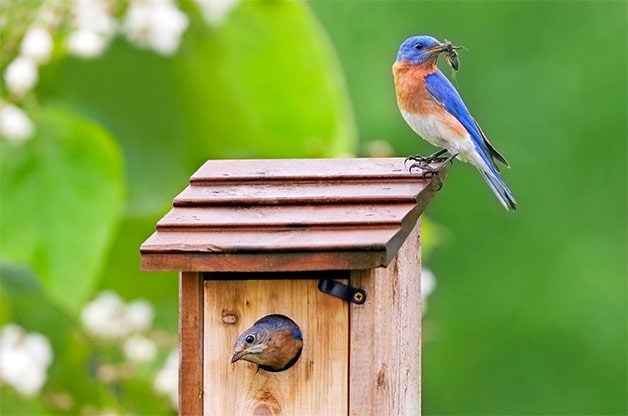
Volunteers put up boxes and then keep an eye on them to make sure they’re predator-free throughout the spring breeding season. They also document important information, including the number of eggs and nestlings, and send their findings to the North American Bluebird Society and the Cornell Lab of Ornithology, where researchers study the data.
The movement to save these sky-blue thrushes with their cheery songs began in the 1920s, when habitat changes were causing the birds to lose their natural cavity-nesting sites. They also were getting kicked out of their nests by an increasing population of nonnative birds, such as house sparrows and European starlings. The North American Bluebird Society was formed in 1978. The group shared and promoted information based on decades of research by bluebird fans—where and how to mount the bluebird box, and how to deter predators and nonnative nesters.
Today, monitors in North America belong to many regional, state and national bluebird conservation groups. Thanks to their efforts, the bluebird populations have bounced back.
When volunteers with the Colorado Bluebird Project first began monitoring the birds, fewer than 100 nesting attempts were reported, says Kevin Corwin, Colorado project manager and North American Bluebird Society board member. Now, in a typical year, volunteers in that state report 1,400 to 1,500 attempts (with at least one egg) in nest boxes.
“The key is commitment,” Kevin says. “You have to go out there once a week, check the boxes, document what you see, and if you have an issue like predation, figure out how to solve it.”
Check out the best bluebird feeders and feeding tips.
How to Become a Bluebird Monitor
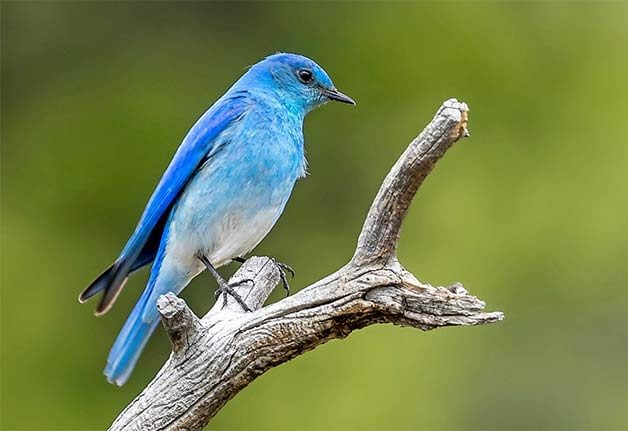
The best way to begin your bluebird monitor journey is by reaching out to a local, state or national bluebird society. Experts like Kevin can help you get started monitoring a bluebird trail that’s already been set up or can provide information on ways to create your own. You can even put up just one box in your yard as long as you have the right habitat. Semi-open grasslands, like meadows, orchards and mowed lawns, are best. Western bluebirds especially like open lands near ponderosa pines, Kevin says.
Bluebird boxes can be purchased or homemade. Look for boxes and designs approved by the North American Bluebird Society. Fact sheets and plans spell out important details—like the size of the box’s entrance hole. If the entrance hole is larger than 1½ inches, European starlings may get inside.
Learn how to make a DIY bluebird house.
Depending on where you live, bluebirds may raise two or three broods each year. Leave your nest boxes up year-round and clean them out after the nesting season is done.
How to Maintain a Bluebird Box
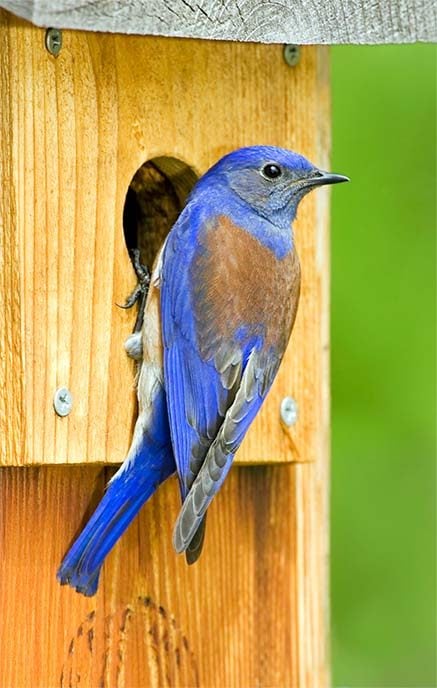
Once you become a bluebird monitor, you’ll learn to note when eggs are laid and count the days until the young hatch. Don’t worry too much about scaring away the bluebirds when you’re monitoring the boxes. Most of the time, “they’re very tolerant,” Kathy says. You’ll also figure out when the young are almost ready to fledge; then you have to stay away from the box entirely.
Checking to see if other birds are attempting to nest in the boxes is a critical task for monitors. House sparrows are nonnative, so it’s legal to remove their nests. However, leave the nests of tree and violet-green swallows alone—they are native birds and fun to watch, too! Sometimes, placing two bluebird boxes close to one another allows one pair of swallows and one pair of bluebirds to nest side by side.
Monitoring bluebirds is not without challenges and sad times, such as when the eggs don’t hatch. It’s all part of the job. But if you observe the box carefully and do your homework, the chance of negative outcomes should diminish.
“Bluebirds are among the most beautiful animals in the world,” says Kathy. “You have to admire their spirit and determination. There’s just something about them that makes you want to help.”
Next, check out our guide to feeding mealworms to birds.
There’s something so thrilling about finding a nest with baby birds in your yard. It tells you that you’ve been successful in creating a space where birds feel safe and find the resources they need to raise a family. Plus, it gives you the chance to observe the nesting process from start to finish, and that’s fascinating no matter how many times you see it. Attracting nesting birds isn’t just a matter of luck. There are plenty of things you can do to make your yard more inviting to them. Follow these tips to prepare for bird nesting season.
Provide Lots of Shelter
With very few exceptions, most birds need sheltered locations to nest. Some prefer tree cavities, others build nests on branches or even the ground. Learn about 8 different kinds of bird nests and how to spot them.
Having plenty of trees on your property increases your chances of attracting nesting birds. You can also provide nest boxes for them. You’ll have the most success with nest boxes if you carefully consider the species you’d like to attract and choose boxes made just for them. Here’s how to attract nesting birds to birdhouses.
While some birds reuse nests from year to year, their nesting sites and birdhouses do need to be properly maintained. If you have nest boxes, clean them out in early spring each year to prepare for the new nesting season. Remove any old nest material and check to see if the box had other residents, like mice, during the winter. If so, give the box a good wash with soapy water, rinse it well, and leave it out in the sun to dry.
Help birds prepare for the new nesting season by putting out materials they’ll need to build their nests. Bits of yarn or twine, hair, cotton, straw and other natural materials are ideal. Learn how to make DIY grapevine balls for nesting birds.
Protect Nesting Birds From Predators
Predators are an enormous threat to birds in nesting season. Ensure your yard provides plenty of cover in the form of shrubs, trees, and tall grasses—places where birds can hide. Thorny bushes are especially great cover. Choose nesting boxes without perches, as these make it easier for predators to get into the boxes. Keep cats indoors to protect birds.
Grow Natural Food Sources
Strange as it may seem, some birds are actually less likely to visit your feeders during nesting season. That’s because they need a tremendous amount of protein to stay strong and help their nestlings grow. They generally get that protein from insects. So add plenty of native plants to your yard to attract beneficial bugs, and avoid pesticides whenever possible. While you’re at it, plant natives that provide lots of seeds and berries, and you’ll have a bird buffet that goes way beyond feeders. Learn more about what baby birds eat.
How to Watch Birds in Nesting Season
Once you’ve attracted nesting birds to your yard, of course you’ll want to check out all the action. But it’s important to do this in a way that’s safe for the birds, and legal for you. Try to visit the nests only during the middle of the day, and limit your visits. Your activity can alert predators to the nest’s presence. (Want to feel like a real scientist? Become a bluebird monitor.)
In general, look but don’t touch. Nearly all birds are protected by the International Migratory Birds act, which makes it illegal to disturb or handle active nests. Don’t try to move a nest, even if it’s in an inconvenient spot.
Know When to Help
If the bird is injured, do not attempt to care for it yourself. This is illegal. Contact a licensed wildlife rehab center immediately. Learn what to do if you find an abandoned bird nest or baby bird.
Join NestWatch to Report Nesting Birds
Help scientists learn more about nesting birds and their behavior by signing up for the NestWatch program from the Cornell Lab of Ornithology. Get certified and then monitor and report on nests in your yard or anywhere nearby. The website offers plenty of great resources on birds and their nests, and your data will help monitor the health of bird populations around the globe.
Next, check out super cute photos of baby birds.
Every year, we invite Birds & Blooms readers to send us their best bird, butterfly and bloom photos for our annual Backyard Photo Contest. For our 2020 contest, we received thousands of extraordinary entries and our editorial team narrowed it down to 12 finalists. From there, we turned it over to you to vote for your favorites.
So, without further ado, the grand-prize winner of the 2020 Birds & Blooms Backyard Photo Contest is….
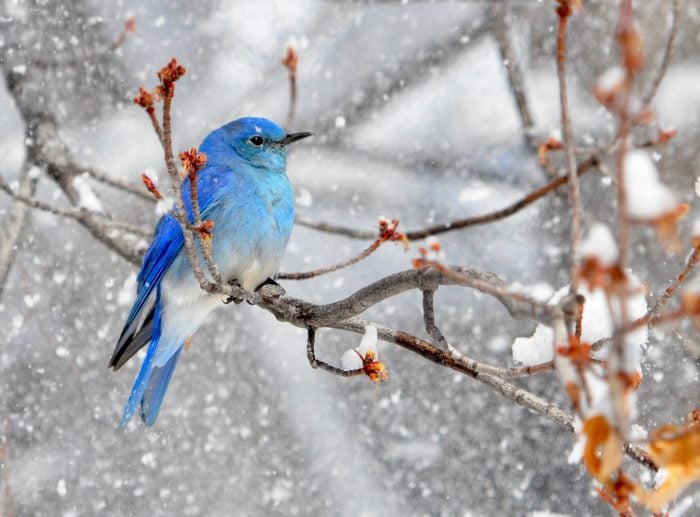
Laurie Normandeau of Longmont, Colorado, for her wonderful photo of a mountain bluebird.
In her original submission, Laurie said: “I noticed this mountain bluebird while I was on a morning walk around the neighborhood with my Nikon D700 camera, looking for photos while the snow was still falling. The bluebird was exhausted, alone and seemed unaffected by my presence. This photo was taken during the start of the COVID-19 lockdown, when everyone was staying at home, feeling confused and isolated. I could relate to this bird; disoriented, alone and waiting for the storm to pass.”
Thanks for the thousands of readers who submitted and voted for their favorite photo in the 2020 Backyard Photo Contest! Keep your eyes peeled in summer when we’ll announce our 2021 Backyard Photo Contest dates and open for photo submissions.
If you are like many birders, you’re looking for any excuse to escape the cold and snowy northern winters. Birding can give you the perfect excuse! These hot birding trips could be your ticket to a warm and bird-filled winter vacation! Psst—if you don’t mind cold weather, check out these birding hotspots for incredible winter birds.
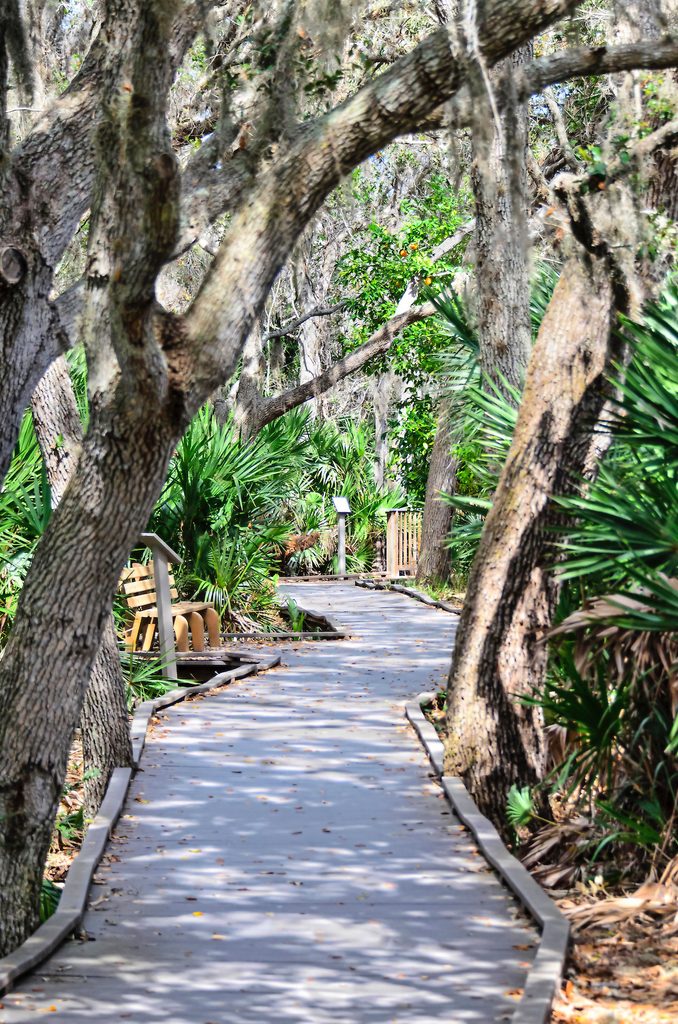
Merritt Island National Wildlife Refuge: Titusville, Florida
Special sightings: roseate spoonbill, reddish egret, Florida scrub-jay
Situated a few miles south of the Kennedy Space Center, Merritt Island is one of central Florida’s best spots for a winter birding trip. An array of migratory waterfowl flock here in the thousands, which offers visitors chances to see hooded mergansers, northern pintails and many more.
Regular residents include some of Florida’s best species like the roseate spoonbill—and alligator sightings are pretty much guaranteed. Take the 7-mile Black Point Wildlife Drive through saltwater marsh and pine flatwoods for easy viewing of the refuge’s most fascinating creatures. Look for songbirds and raptors while hiking the Cruickshank Trail, and scan the roadsides toward Canaveral National Seashore for your best chance to see scrub-jays.
Also explore Ding Darling National Wildlife Refuge in Florida.

Santa Ana National Wildlife Refuge and Bentsen-Rio Grande Valley State Park: Hidalgo County, Texas
Special sightings: green jay, plain chachalaca, hook-billed kite
Spot Central American fliers without needing a passport. Take a winter birding trip to this Texas hot spot just north of the Mexican border. Late winter and early spring are primebirding seasons here, with very mild temperatures and abundant wildlife.
The feeders outside the Santa Ana National Wildlife Refuge visitor center attract southern favorites like Altamira orioles and golden-fronted woodpeckers. Hike the lake trails to see three types of kingfishers (green, belted and ringed) and plenty of other water lovers.
Twenty miles west, Bentsen-Rio Grande Valley State Park offers a two-story wheelchair-accessible Hawk Observation Tower to give you a true bird’s-eye view. Don’t miss the nearby National Butterfly Center, where plantings have attracted more than 230 butterfly species, including rare tropical visitors.
A short distance away, Corpus Christi has been called the “Birdiest City” in the U.S. and you’ll understand why after one visit! From Aransas National Wildlife Refuge north of town to Padre Island National Seashore to the south, you’ll find plenty of incredible birding areas around this city.

San Pedro Riparian National Conservation Area: Hereford, Arizona
Special sightings: ferruginous hawk, golden eagle, pyrrhuloxia
Southeast Arizona is one of the most biologically diverse areas in the United States. Deserts, canyons and isolated mountain ranges known as sky islands provide habitats for hundreds of avian species throughout the year.
Trails starting at San Pedro House, a historic estate in the park, route along the river through cottonwood forest. Here you’ll spot specialties like the Gila woodpecker, black phoebe and Abert’s towhee. In desert areas, look for curve-billed thrashers and wintering flocks of lark buntings.
Drive less than an hour east to the Whitewater Draw Wildlife Area to see a massive gathering of more than 20,000 wintering sandhill cranes, along with other wading birds and waterfowl. Ferruginous hawks, the largest hawks in the U.S., are found here, too.
If you are looking for a winter birding trip to really escape and get away, Portal, Arizona, might be for you. Situated in the Chiricahua Mountains in Southeast Arizona, this town is miles from anywhere but offers incredible birding!
Explore the beauty and history of Verde Valley, Arizona.
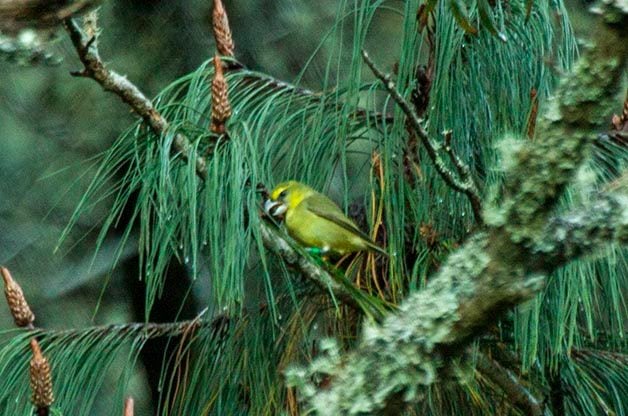
Hawaii
Sure, this location is much farther away for a birding trip, but who doesn’t want to spend some time on these fascinating islands. With Hawaii recently being added to the ABA area, many birders are making plans to visit. There are many beautiful species that are endemic to the islands, such as the Nene, Hawaii’s state bird. The Hawaii Audubon Society offers many details on the best hotspots on each island, including Kilauea Point National Wildlife Refuge.!
For many people, it might sound crazy to head north in the winter instead of south but serious birders know there are plenty of incredible birding hotspots to visit even when it’s freezing. Owls tend to be the main species that draws birders north in the winter but there are many more birds to see! Here are some of the best places to visit for winter birding.

Klamath Basin: Northern California and Southern Oregon
Special sightings: Barrow’s goldeneye, bald eagle, white-headed woodpecker
The Klamath Basin is a major layover on the famed Pacific Flyway. Multiple freshwater habitats—including lakes,rivers and marshes—attract wading birds and waterfowl in absolutely unbelievable numbers.
Snow geese, cackling geese and Ross’s geese are winter regulars, along with Clark’s grebes and common and Barrow’s goldeneyes. More than 500 bald eagles, the largest concentration in the continental U.S., spend winter around the Klamath Basin. Combine a drive along the 10-mile Lower Klamath National Wildlife Refuge Auto Tour Route marshes with a trip to Lava Beds National Monument’s upland habitat to maximize the diversity of your sightings. Check out coast to coast birding hotspots for every season.

Cape Henlopen State Park and Delaware Seashore State Park: Sussex County, Delaware
Special sightings: snow bunting, long-tailed duck, razorbill
Delaware’s Cape Henlopen State Park offers views of both Delaware Bay and the Atlantic Ocean and is a haven for wintering geese, ducks and other waterbirds. You’ll find all three types of scoter here, alongside diving seabirds like northern gannets. Look closely at flocks of double-crested cormorants, as great cormorantsoften mingle with them. Scan the dunes for snow buntings or even the rare Lapland longspur.
Nearby Delaware Seashore State Park’s Indian River Inlet is another excellent location where you might spot pelagic species like razorbills, dovekies or murres. Discover the top 5 birding hotspots for fall migration.

The Niagara Birding Trail: Niagara and Erie County, New York
Special sightings: Iceland gull, peregrine falcon, harlequin duck
The Niagara River Corridor, which includes Niagara Falls and the Niagara Birding Trail, is a popular tourist destination and a special place for winter birders. If you love gulls, Niagara Falls is the place to be! Thousands of gulls can be seen here in winter. Waterfowl gather in multitudes, including many that breed in the far northern Arctic, like Iceland gulls and tundra swans.
Areas directly surrounding the falls, including Goat Island, are ideal places to look for up to a dozen gull species, with the possibility of rare visitors such as black-headed gull. Woodpeckers, nuthatches and titmice abound at feeders and along wooded trails on the Dufferin Islands, offering a tranquil break from the falls. Don’t miss the 51 best winter bird photos.
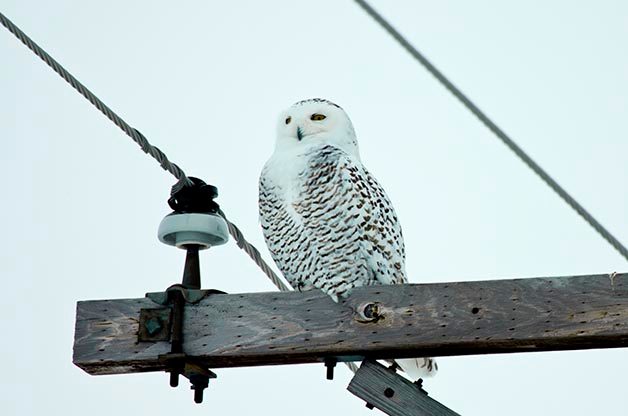
Upper Peninsula: Michigan
Special sightings: Snowy owl, boreal chickadee
There are so many great places to go birding in the UP. From Sault Ste. Marie in the eastern UP all the way to the Kewenaw Peninsula in the west, you can spend at least a week visiting all the awesome spots. Highlight species include snowy owl, Canada jay, spruce grouse, evening grosbeak, and boreal chickadee.
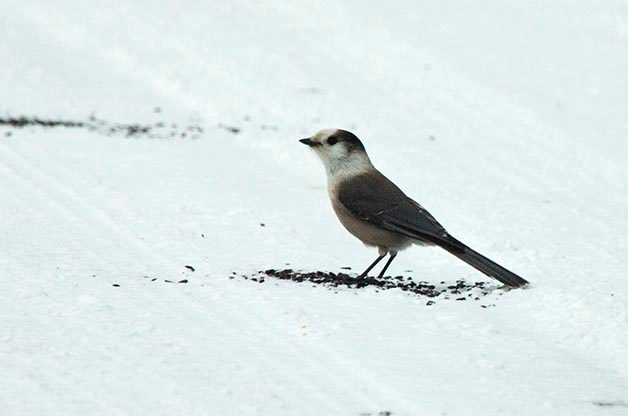
Duluth/Sax-Zim Bog: Minnesota
Special sightings: Great gray owl and Canada jay
This part of Minnesota is likely the most well-known winter birding destination. It tends to get more owls each winter than the UP and is really well developed with services for birders. In addition to being great for owls, you can find Canada jay, black-billed magpie, pine grosbeak, common redpoll, both red and white-winged crossbills, and plenty of gulls. It’s also a good spot to look for Gyrfalcon, as well as home to the National Eagle Center—a winter birding paradise! Meet the boreal birds of the Northwoods.
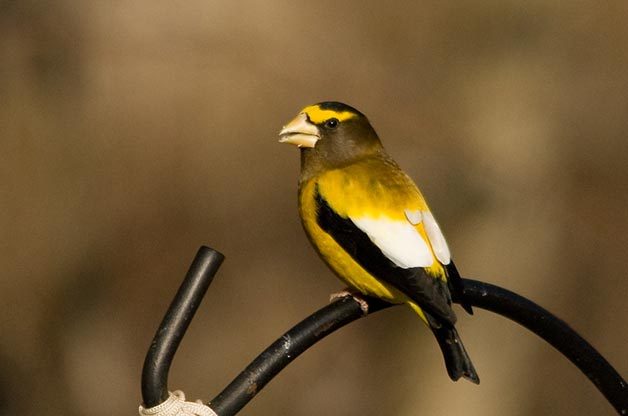
Algonquin Provincial Park: Ontario, Canada
Special sightings: Winter finches
For a bit more of an adventure, head north of the border to this park that is northeast of Toronto, Canada. The bird feeders at this park are a great place to see tons of winter finches. Look for purple finches, pine siskins, common redpolls, red and white-winged crossbills, and evening and pine grosbeaks.
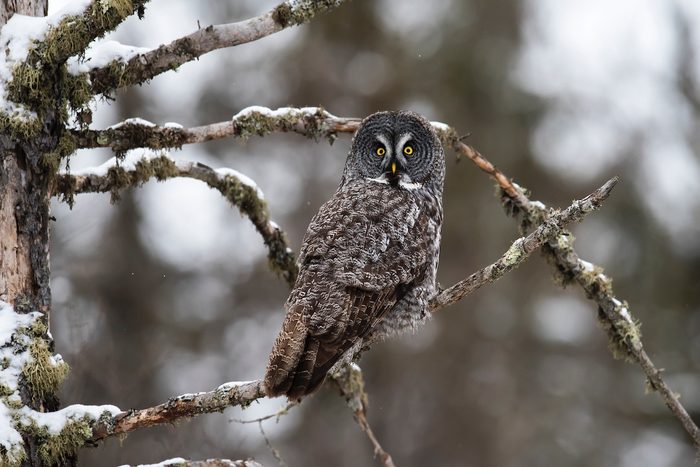
It’s cold, buried in snow for much of the year and infested with mosquitoes and biting flies for the rest. Seems like an inhospitable place, doesn’t it? Not to everyone. The Northwoods, as the boreal forest is also called, is one of the largest ecosystems on earth. It stretches around the northern quarter of the planet, across three continents. In North America, the habitat is mostly in Canada and Alaska, though small portions reach down into the upper Midwest and Northeast. It’s a rough, wild and dark place, but for a staggering number of birds, that huge swath of woods is something else: home.
Check out the 51 best winter bird photos ever.
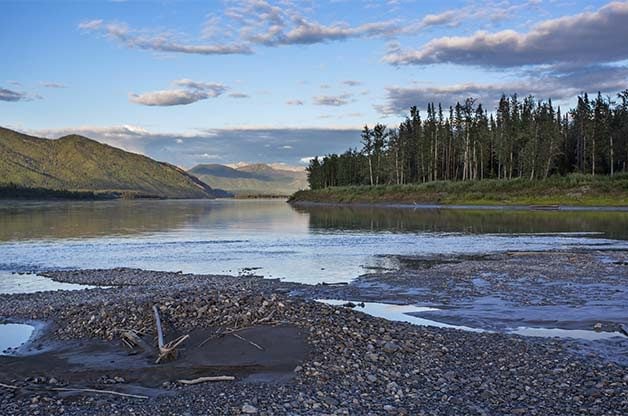
Long Chilly Winter Days
On a frigid January day, when the sun is above the horizon for just a few hours, the boreal forest can seem lifeless. Then, suddenly, it isn’t. Flocks of boreal and black-capped chickadees materialize, their calls bouncing back and forth as they move through the trees. A downy or hairy woodpecker may appear with the group, tapping dead branches as it probes for hibernating insect larvae. Above, a raven passes, croaking. Gliding through the woods like a ghost, a hulking northern goshawk spooks a ruffed or spruce grouse from its resting place on a low branch.
The few resident species use a variety of adaptations to survive the long winter. Chickadees cache food during summer, and use their remarkable memory to recover it when they need it most. The grouse move into the trees to dine on spruce tips, or forage through the brambles looking for frozen berries left over from autumn. Flocks of redpolls, northern finches, take advantage of many pairs of eyes to search for rich foraging areas. Redpolls store seeds in a small pouch in their esophagus, which they draw on during the long, bitterly cold nights.
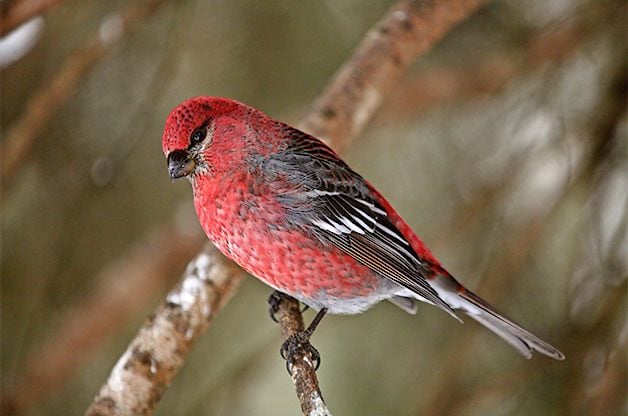
Spring Migration
By March and April, the sun is rising far above the horizon. The first spring migrants arrive as the snow begins to melt. Dark-eyed juncos are almost always the first to come back, but within days, more species arrive: American robins, ruby-crowned kinglets, yellow-rumped warblers and fox and white-crowned sparrows. The silence of winter disappears with the snow by May, when about 150 bird species fill the boreal forest with song.
Summers are short in the north; both the migrant and resident birds make the most of the long days. They establish territories, pair up, build nests, lay eggs and raise their young in less time than do birds who breed farther south. Some species, like the alder flycatcher, spend an average of fewer than 50 days on their breeding grounds. In Alaska, this diminutive gray-green bird arrives in early June and is often gone before the end of July. Other species are also in a rush, and with little time to re-nest if something goes wrong, they are under pressure to succeed.
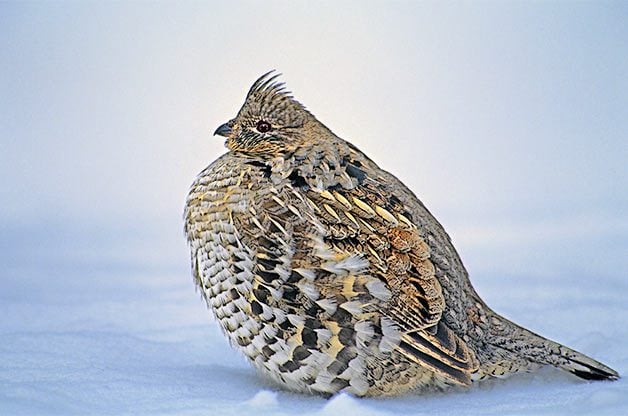
By August, the area is teeming with newly fledged songbirds, and ponds are dotted with broods of ducklings. Mixed species flocks form and move through the forest, searching for food while keeping out a wary eye for predators. Orange-crowned, yellow, blackpoll and yellow-rumped warblers mix with juncos, American tree, white-crowned and Lincoln’s sparrows as they flit through the trees. The breeding season has passed; now the young birds are practicing their songs like kids learning new musical instruments. The resulting notes are mixed up and off-key and never fail to bring a smile to the listener.
Fall Migration
In October, the last of the trumpeter and tundra swans migrate. In white V’s they pass over the mountains and forests on their way to their southern wintering grounds. The other migrants are gone, and the few resident species are left alone as snow settles in once more.
The boreal forest is rugged, wild and often punishing. Unlike other landscapes, such as the mountains or coasts, the boreal forest takes effort to fully appreciate. The birds are easy to love, though. In winter, most of the birds of the Northwoods scatter like a cloud of confetti. You’ll find them from the southern tip of South America to the American Great Plains, from the swamps of the Southeast to the coastal estuaries of the West.
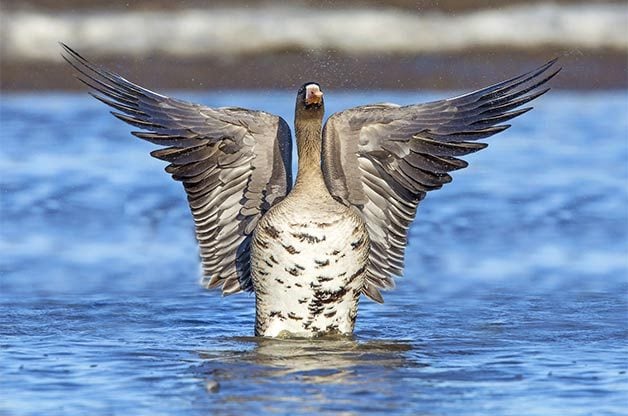
and fall migrations to and from their Arctic breeding grounds.
Spend more than a few minutes watching a bird feeder or glassing ducks at the local pond or birding along a coast, and odds are excellent that a good portion of the birds you see will have hatched or migrated through the boreal forest. It’s a nursery for an estimated 3 billion birds. Without them, not only the north, but the entire continent would be sadly bereft. The boreal forest is essential because the birds that depend on it are a part of all of our lives.
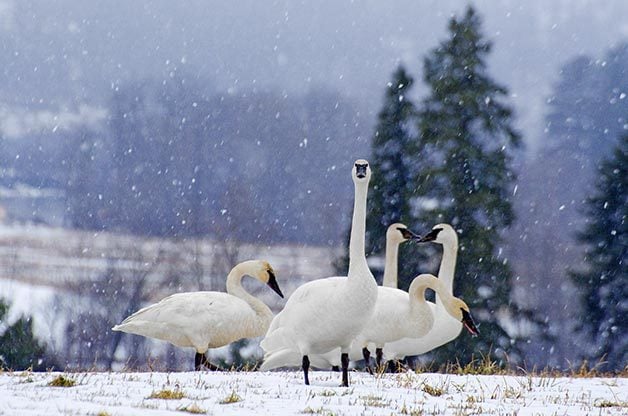
Experience the Boreal Forest
The northern forest is huge and wild, but these areas are accessible to bird-watchers.
Boundary Waters Canoe Area Wilderness, Superior National Forest, Minnesota
Part of the southern reach of the boreal forest touches into northern Minnesota. Huge lakes, winding rivers, meadows and woods are habitat for 163 nesting bird species, including 24 warblers.
Terra Nova National Park, Newfoundland, Canada
This is Canada’s easternmost national park and it combines ancient boreal forest with a stunning coastline, forming a perfect bird habitat. The park is a globally recognized Important Bird Area.
Yukon-Charley Rivers National Preserve, Alaska
Encompassing 3,946 square miles of mountains, rivers, forest and lakes, this area is not easy to get to, but it’s worth the effort. Millions of songbirds, waterfowl and shorebirds breed and migrate through the preserve each year.
From plump red cardinals huddled along a fence to a sleepy owl with snow-covered feathers, warm up with 51 amazing winter bird photos from Birds & Blooms readers.
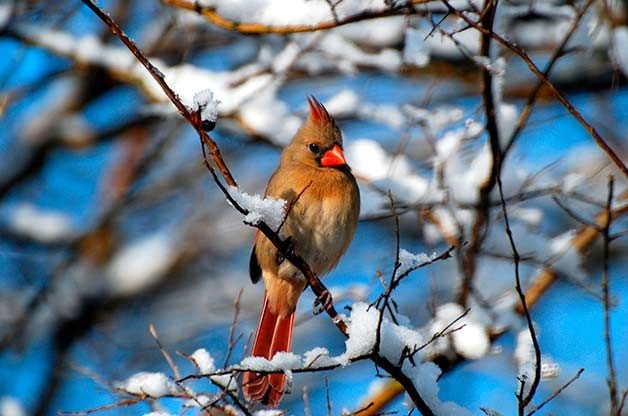
1. Northern Cardinal
It doesn’t often snow in Alabama, but when it does, watch out! This female cardinal was caught in a rare snowstorm here, and I snapped this photo while she waited her turn for seed at the bird feeder. —Nelda Faulkner of Leeds, Alabama
Check out 21 simple tips to attract winter birds.
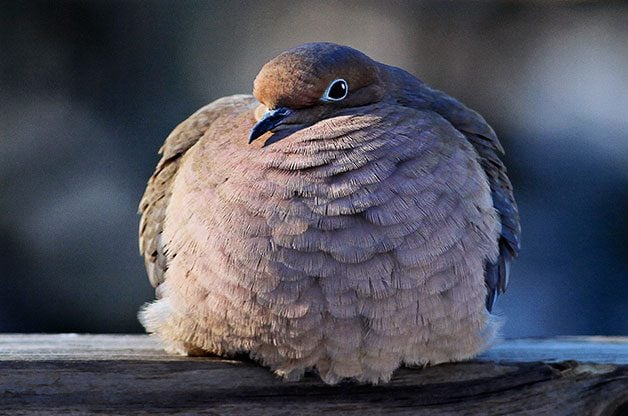
2. Mourning Dove
At 7 degrees, it was a cold late afternoon in January. This mourning dove was puffed up as large as possible to retain all the heat it could. —Bob Anderson of Severna Park, Maryland
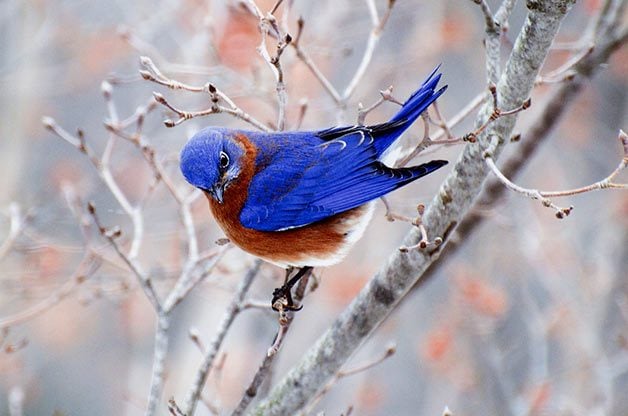
3. Eastern Bluebird
Eastern bluebirds are so beautiful and entertaining. My husband and I love feeding them and watching them hop around our rural Connecticut yard. In late February, the bluebirds return from their winter retreats and scout for nests. This male eastern bluebird landed in our kousa dogwood tree after he discovered some dried mealworms waiting for him. —Lucinda Moriarty of East Hampton, Connecticut
Check out 4 foods to feed birds in winter.

4. Mockingbird
All types of birds visited our feeders last winter, and this particular mockingbird stopped by every day. I wanted to get a photo of it, and as I lifted the camera, it turned to look right at me. It seems to be saying, “What are you looking at?” —Donna Pittman of Mountain Home, Arkansas
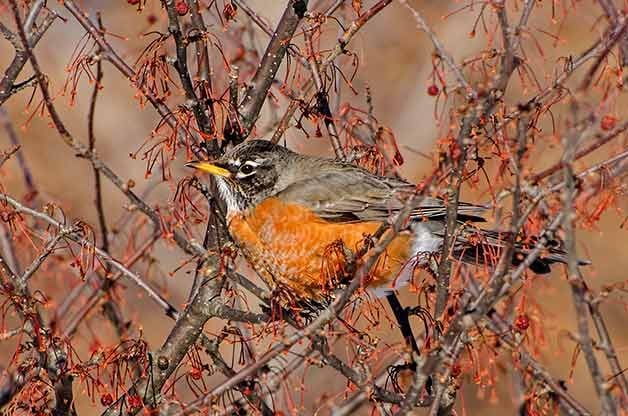
5. American Robin
Our son-in-law’s tree nursery has tons of winter birding opportunities, especially when it comes to bluebirds, cedar waxwings, and American robins like this one. They come to feast on crabapples hanging in clusters from bare branches. I love walking among the nursery trees, watching as hungry birds forage for drying fruits. —Fred Hardwood of Sheffield, Massachusetts
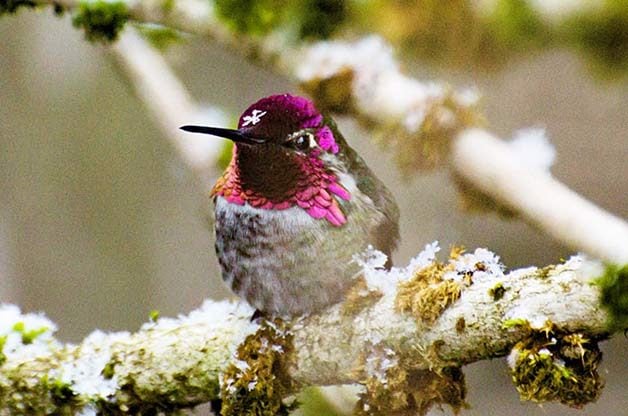
6. Anna’s Hummingbird
We had a little snow last winter, and this Anna’s hummingbird was still hanging around our backyard. A single snowflake landed on its head. I was so happy to have caught this moment on camera. —Melissa Jones of Longview, Washington
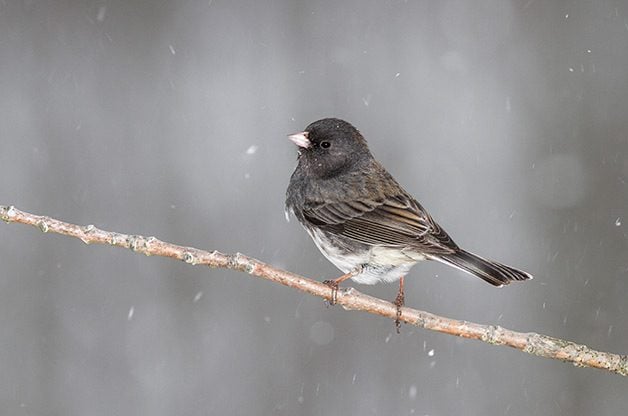
7. Dark-Eyed Junco
Dark-eyed juncos visit my home state of Kentucky only in wintertime, so this snowy background fits quite well. —Jack Dean of California, Kentucky
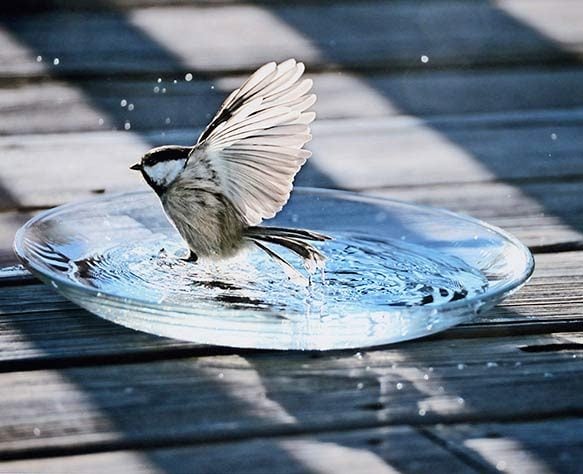
8. Black-Capped Chickadee
Black-capped chickadees splashed in tiny bits of melting snow one early spring day on our deck. I wanted to make things easier on them, so I put out a dish of warm water. They really seemed to enjoy their first bath of the season. —Nina Graff of Crystal Falls, Michigan
Check out 20 incredibly cute chickadee pictures.
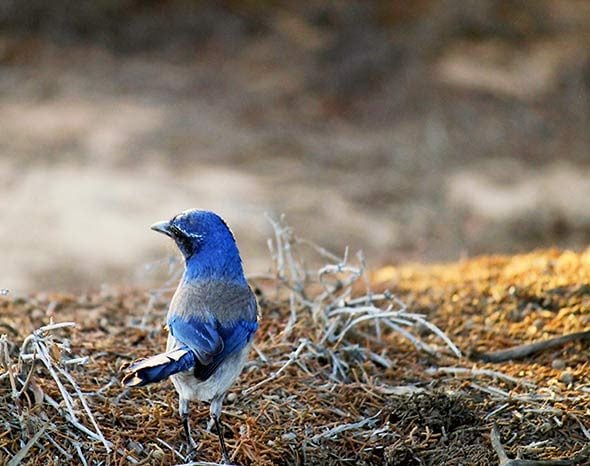
9. California Scrub-Jay
Last February, I explored the Prime Desert Woodland Preserve in Lancaster, California. I had gone to the park around sunset to take pictures of the eye-catching Joshua trees. A California scrub-jay landed nearby, and the evening light hit its side perfectly. Sometimes the best photos are lucky accidents. —Alycia Raby of Lancaster, California
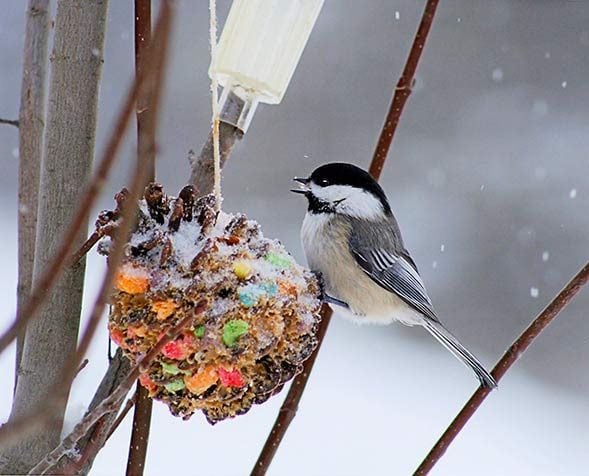
10. Black-Capped Chickadee
I snapped this black-capped chickadee stopping for a snack during one of the snowiest days last winter. When the weather is so brisk, it’s hard to keep the pinecone feeders full! I think my backyard birds are grateful for the tasty treats. —Cindy Shiock of Reynoldsville, Pennsylvania
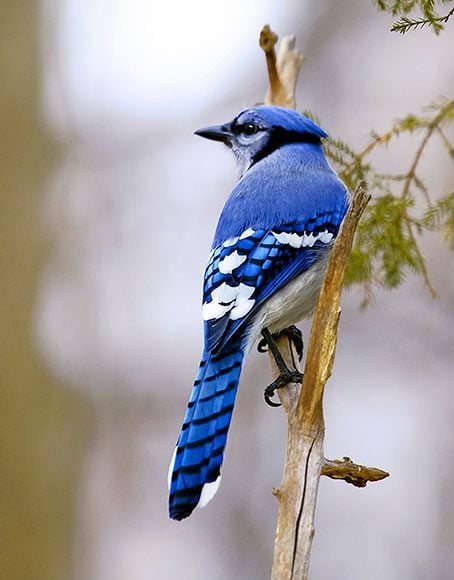
11. Blue Jay
Winter can be harsh here, but a pleasing photo makes braving the elements worth it. I was excited to take my new DSLR camera for a spin, and this blue jay was cooperative long enough to take a second look at me. Then it sounded its jay-jay alarm and flew off into the cold. —Lucian Parshall of Brighton, Michigan
Discover 6 fascinating facts about blue jays.
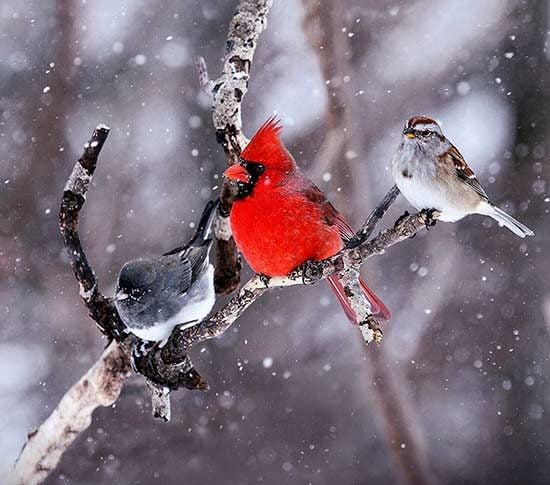
12. Winter Bird Photo
My backyard birds needed a spot to wait their turn at the feeder, so I set up a tree limb nearby. One morning, these three birds stopped over for breakfast. From left, I identified their species: junco, northern cardinal and American tree sparrow. Though they don’t usually tolerate each other, they all sat together as the snow fell around them. —Phil Loparco of Cortland, New York
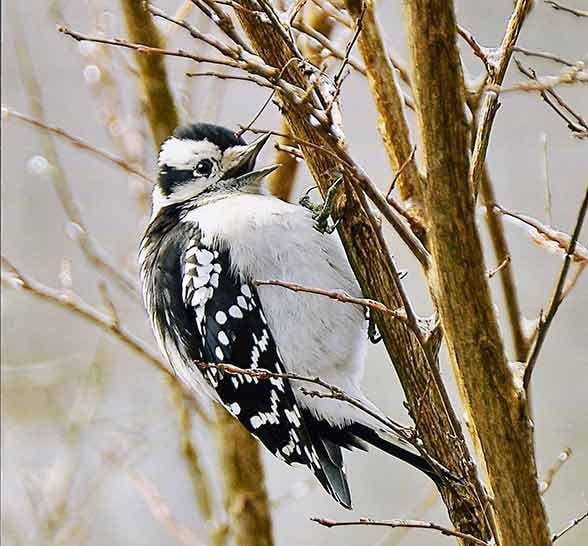
13. Downy Woodpecker
I was thrilled to catch sight of this downy woodpecker with its feathers all puffed out to stay warm one icy morning. To me, it looks like she’s singing for spring to arrive. —Jean Owens of Paris, Tennessee
Learn how to tell the difference between downy and hairy woodpeckers.

14. Tufted Titmouse
The snow was softly falling when this tufted titmouse came in to feed one early winter morning. It sat on this branch, feathers fluffed to keep warm. This photo is one of my favorites. —Rebecca Granger of Bancroft, Michigan
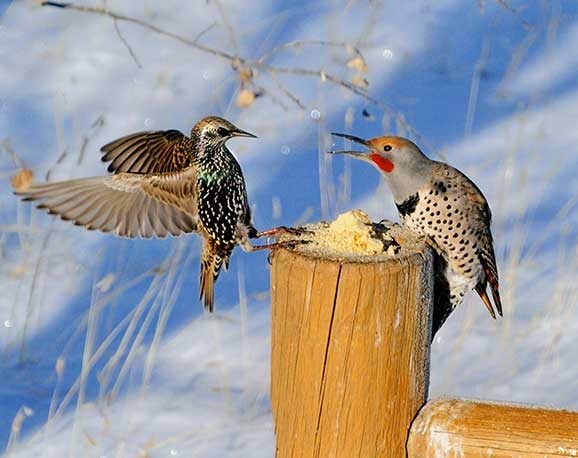
15. Northern Flicker and European Starling
A harsh winter in Flagstaff meant having as many as 25 northern flickers in my yard at one time, bickering over suet cake. I started putting it on the tops of fence posts to reduce the frenzy at the feeder. On this occasion, a European starling flew in for the suet and the flicker chased the starling away. —Pam Koch of Dewey, Arizona
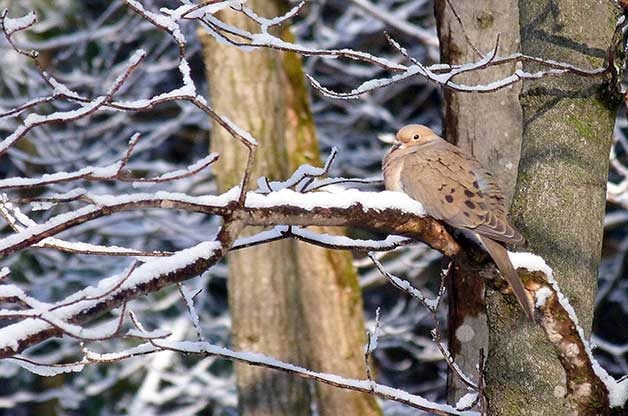
16. Mourning Dove
In the waning days of a very long winter, I stood on my porch one morning wishing that spring would suddenly appear. Just then, this mourning dove landed on a nearby maple tree branch and, for that moment, brought me the promise that spring might soon come. —Gary Garton of Rhinelander, Wisconsin
Check out 15 breathtaking photos of mourning doves.
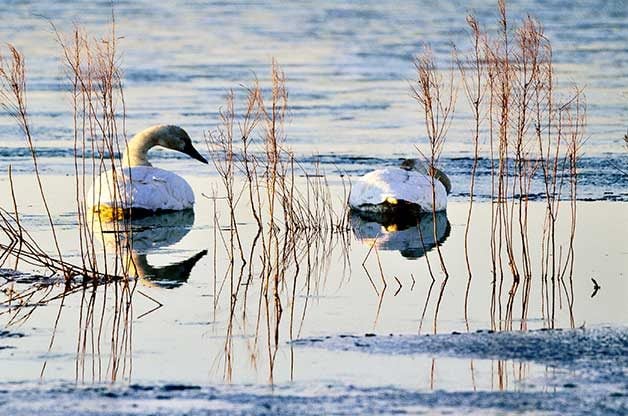
17. Swans
Swans aren’t a common sight here. Imagine my delight when I walked to our pond one morning and spotted a female swan asleep on the ice. I started photographing her as the rising sun’s glow warmed her fluffy body. Later on, her mate joined her. I watched as he swam over and woke her up. You could truly tell they were a mated pair. It was one of the most beautiful things I’d ever seen. I stayed out there in the freezing cold for hours, photographing the lovely swan couple. —Kate Bruce of Zebulon, North Carolina

18. Eastern Bluebirds
It was a bitterly cold winter, but for the first time, we had eastern bluebirds in our yard. After they got a drink from the heated birdbath, they flew over to one of our trees. Initially they were spread out across the branch, but inch by inch they shuffled toward each other until they were huddled together for warmth. —Steve Trupiano of O’Fallon, Missouri
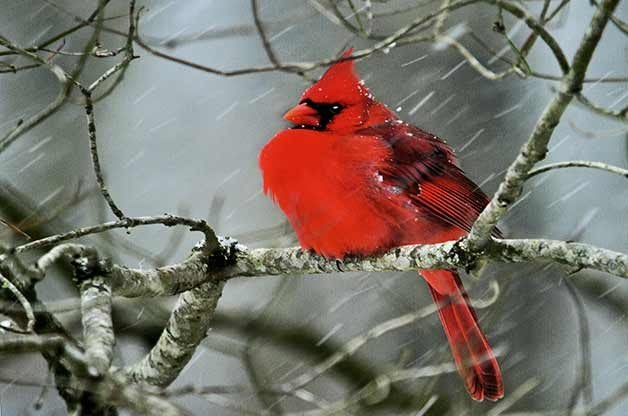
19. Northern Cardinal
If this male northern cardinal was grumpy, I don’t blame him. I was sitting inside where it was toasty warm, and he was out in the bracing cold. He perched in the dogwood tree right outside our kitchen window while a strong dusting of snow came down. Whenever we head to the feeder to fill it up, he peeps excitedly at us. —Madelyn Carr Bonnett of Columbiana, Alabama
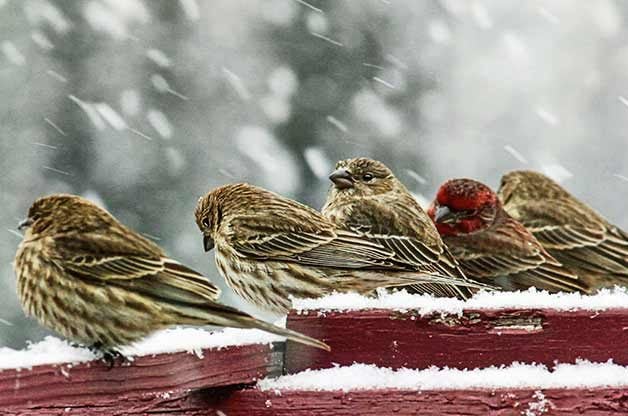
20. House Finches
A few weeks before Christmas, a heavy snow fell and birds flocked to my feeding station. I love bird-watching and I love photography, so I bundled up and went outside to wait for the perfect shot of these freezing house finches. —Robyn Battenfield of Muskogee, Oklahoma
House finches and purple finches: Here’s how to tell the difference.

21. Blue Jay
A sudden snowfall left us (and our backyard birds) with a foot of wet, heavy snow. The feeders were bustling with activity, and at one point, there were about 11 blue jays vying for a spot at one feeder alone. I was pleased to get some pictures of this royal-looking bird as it rested stoically on a honeysuckle branch. As I snapped away, snow continued to pile up, including on the blue jay itself. —Brian Rohland of Bloomer, Wisconsin
Meet the Jays: Blue jays, California scrub-jays and Steller’s jays.
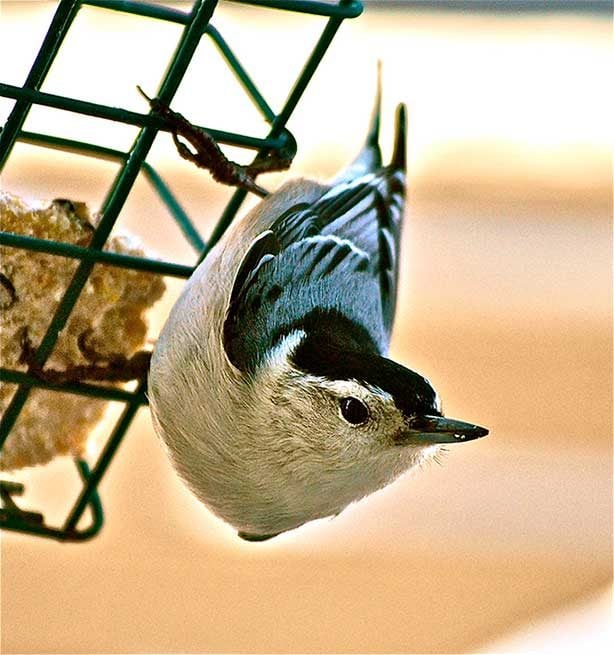
22. White-Breasted Nuthatch
A suet feeder hangs just outside our window all year long, and I try to keep my camera handy for moments like this one. This white-breasted nuthatch joined my wife and me for breakfast one blustery morning, and I took this snapshot to remember how we weathered the winter together. —Doug Wean of Oregon, Illinois
Check out 4 foods to attract nuthatches to your yard.

23. Eastern Bluebirds
Eastern bluebirds are common visitors outside my kitchen window, but I’ve never seen a pair perched like this before. These birds never cease to amaze me with their many different expressions. —Cindi Sathra of Upper Black Eddy, Pennsylvania
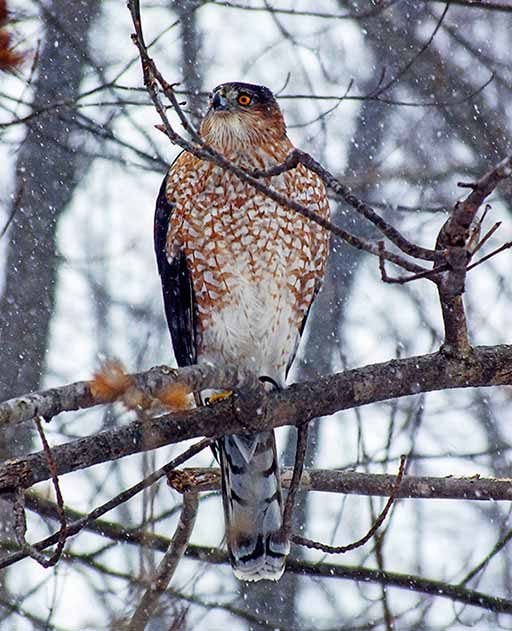
24. Cooper’s Hawk
All I heard was screeching, and at first I thought it might be a blue jay. But I followed the sounds in our wooded backyard, and I discovered this Cooper’s hawk sitting in one of our trees. I knew I had a camera ham on my hands when it let me get super close to take a few snapshots. —Cheryl Pluchinsky of Poland, Ohio
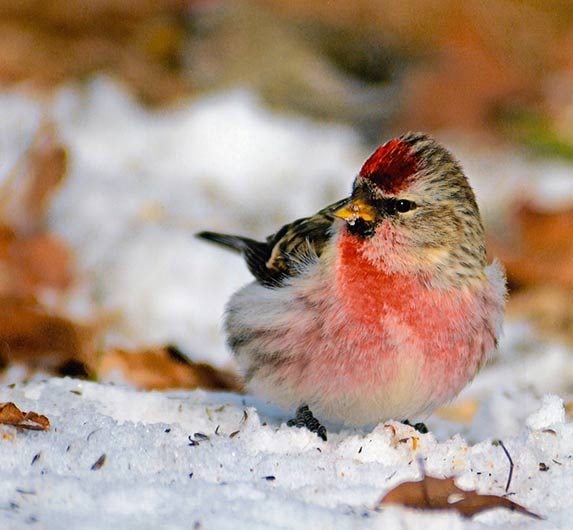
25. Common Redpoll
Common redpolls fly down from Canada in winter to feed as far south as central Minnesota, which is where I live. But if there’s enough food to go around up north, the redpolls won’t usually venture down here. Last winter, experts predicted that this species would stay in Canada for the season, so it was a nice surprise to have a huge flock show up at my thistle feeders from January through early March. I took this from a photo blind, which allowed me to get close and observe these fun little birds feeding undisturbed. —Don Kaddatz of Mora, Minnesota
Meet the boreal birds of the northwoods.
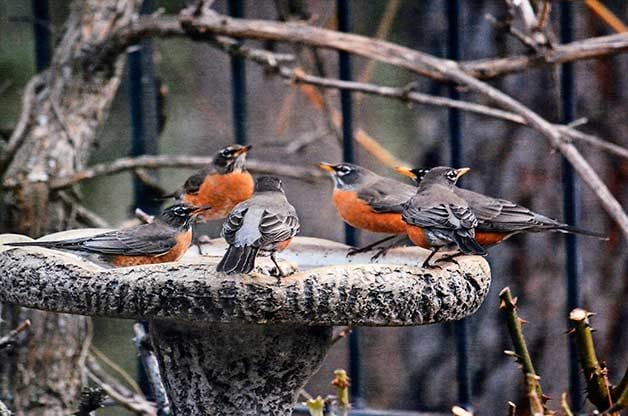
26. American Robins on a Birdbath
Last February, this flock of American robins frequently visited and emptied the birdbath in our front yard. I had to fill it back up every afternoon. What you can’t see in this photograph is all the other bird bathers patiently waiting their turn. —Barb Dienhart of Mokelumne Hill, California
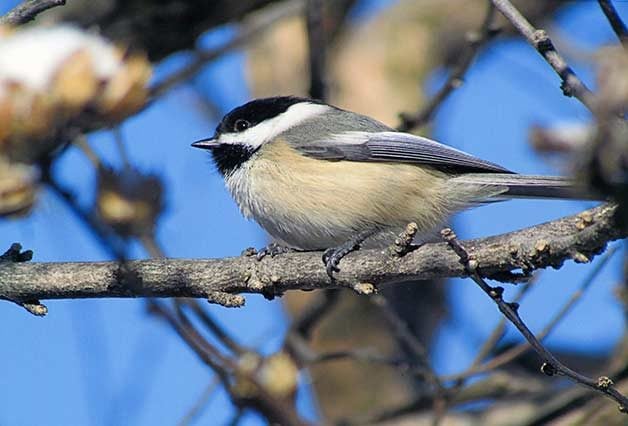
27. Black-Capped Chickadee
Winters can be long and cold in southeastern Michigan, so bird-watching is a favorite seasonal pastime. The black-capped chickadees are amusing to watch as they snatch sunflower seeds from the neighbor’s feeder and land on tree branches to crack the shells open and eat the seeds. This little one took a short break and I was able to capture this moment. I love the beautiful blue sky in the background highlighting the details of its feathers. —Deb Brokaw of St. Clair Shores, Michigan
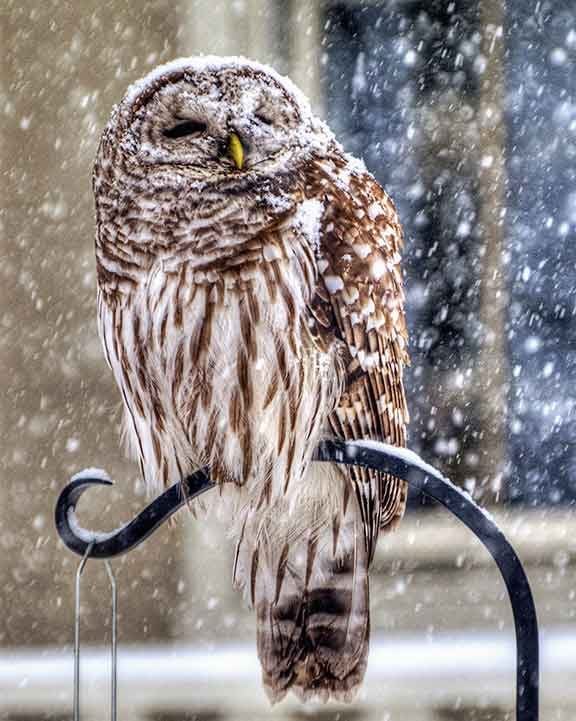
28. Barred Owl
Business at the feeder was uncharacteristically quiet, with the exception of a few noisy crows expressing their displeasure with this barred owl visitor. The owl was as unfazed by the crows’ rude calls as it was by the snow piling up on its head. It perched by the backyard feeder for the entire morning and into the afternoon. —Connie Bocko of Waterville, New York
Check out 15 outstanding pictures of owls.
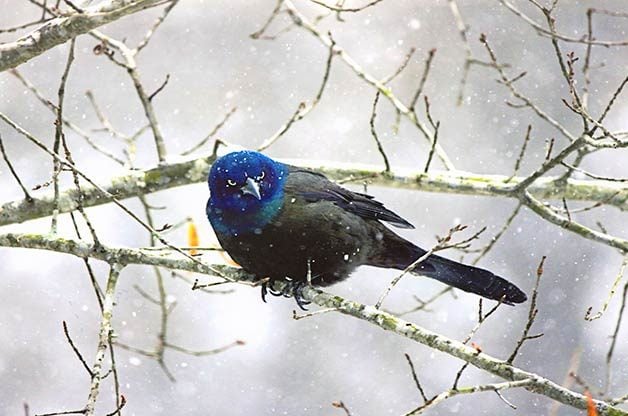
29. Common Grackle
A rare Mississippi snow blew through our area and this common grackle stopped to pout outside our kitchen window. His expression reminds me of an Angry Birds character. I imagine him saying, “I chose to live in Mississippi for a reason! What’s up with all this white stuff falling from the sky?” —Teri Metts of Mendenhall, Mississippi
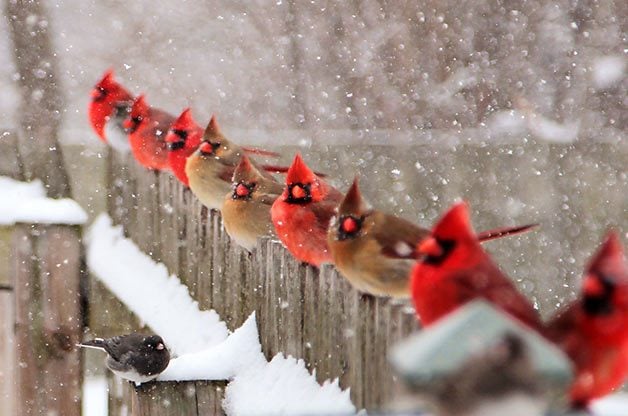
30. Northern Cardinals on a Fence
This wasn’t a normal day with my camera. Just about every male and female cardinal from the surrounding area came in to feed after a harsh blizzard. My fence is usually popular with neighborhood birds waiting their turn to eat, but this was a very special moment. —Carol Estes of LaPorte, Indiana
Discover 6 proven ways to attract cardinals.

31. Tufted Titmouse
I put crunchy peanuts out for the squirrels, especially during winters with heavy snowfall. Last year, I caught this little tufted titmouse stealing away with a few morsels. —Sandi Sullivan of Rensselaer, New York
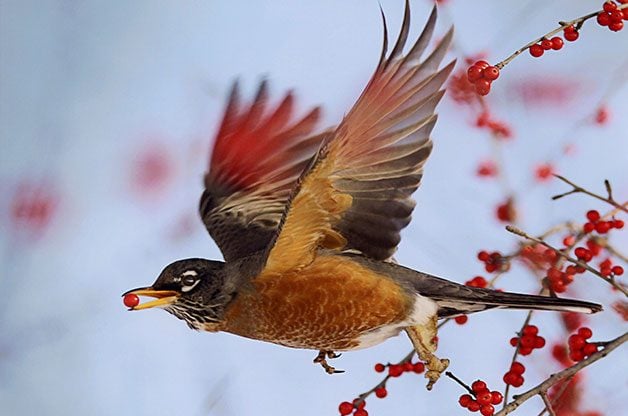
32. American Robin Eating Berries
The American robins were hungry and flying through the air, snapping up berries in their beaks. I watched as this particular bird grabbed a treat and took off. Later, I examined the photo more carefully and noticed his leg. It looks like he lost part of it. What a bird! —Deb Hagen of Hutchinson, Kansas
Learn about 7 backyard birds that eat berries.
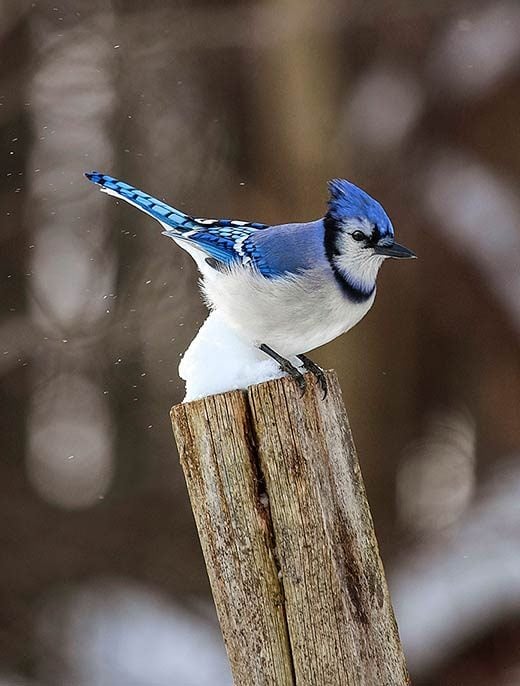
33. Blue Jay
I sat outside in zero-degree weather to get this amazing winter bird photo of a blue jay. The result shows it was definitely worth it! —Jason Baden of Charlotte, North Carolina
Check out 15 of the snowiest bird photos ever!
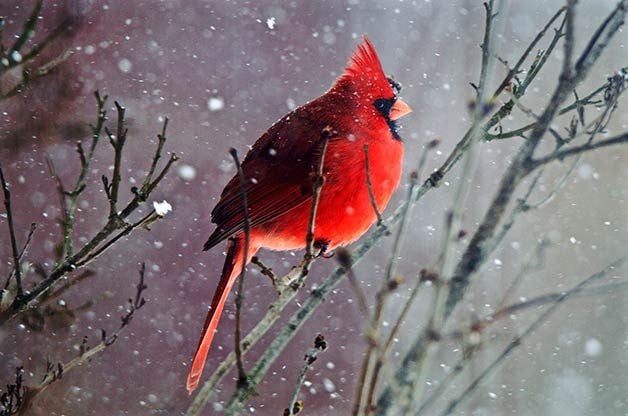
34. Northern Cardinal in Snow
Right outside our back window we have a variety of trees and shrubs that the birds love to use as shelter from the elements. It’s also the perfect photography setup. Cardinals are among my favorites to photograph in winter because of the stark contrast their feathers create with the falling snow. —Noelle Sippel of Webster, New York
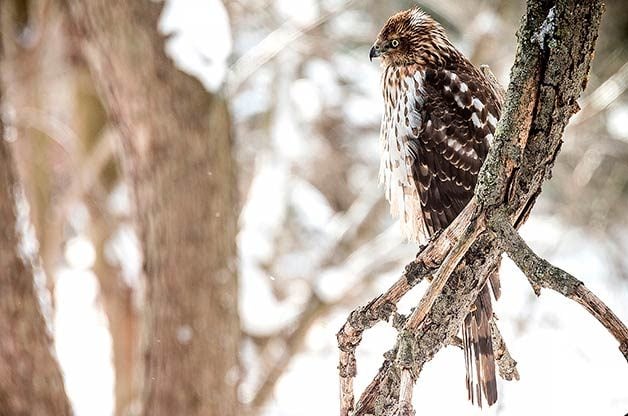
35. Cooper’s Hawk
A juvenile Cooper’s hawk had been hanging around our backyard for a few weeks, always just out of reach of my camera. As luck would have it, the hawk happened to perch outside our bedroom window when the light was just right. I was able to capture
this pretty moment. —Dave Lyman of Kalamazoo, Michigan
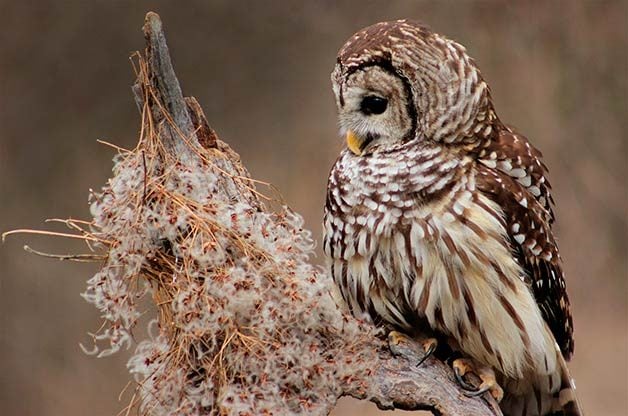
36. Barred Owl
I came upon this barred owl during a chilly afternoon hike in Pinckney, Michigan. It didn’t seem to notice me or care that I was there. The owl was totally at peace, inspecting the tree branch upon which it was perched. —Laura Kelley of Southfield, Michigan
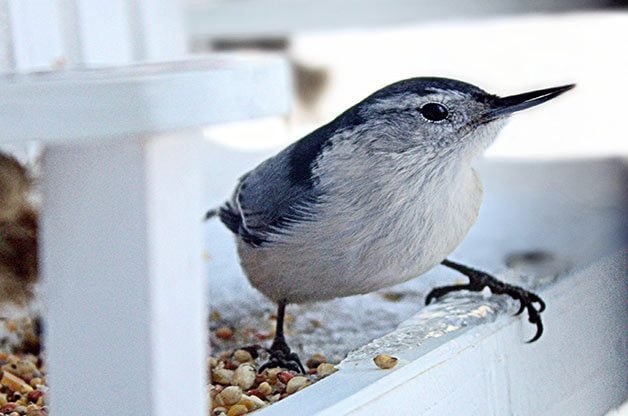
37. White-Breasted Nuthatch
When it snows in Maine, my backyard transforms into a white winter wonderland. Birds take advantage of my many feeders. I love watching them interact with each other or simply stop by to pay me a visit through my camera lens. This white-breasted nuthatch was very determined to get its fill from my feeder, even though the seeds were ice-coated from freezing rain. With the sun shining and that sharp little beak at work, it got its meal. —Catherine Melvin of Windham, Maine
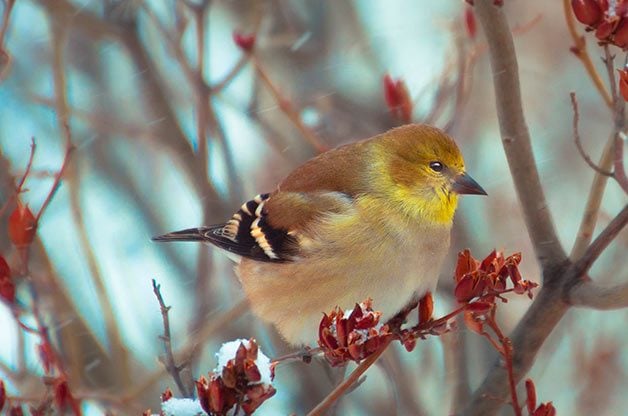
38. American Goldfinch
Last winter was particularly brutal, with frequent snowstorms. The day I took this photo, the lilac bushes in the backyard were full of little birds eating what seeds they could find, despite the weather. This puffed-up goldfinch caught my eye with its bright
streak of yellow on such a dreary day. —Christy Brucks of Mandan, North Dakota
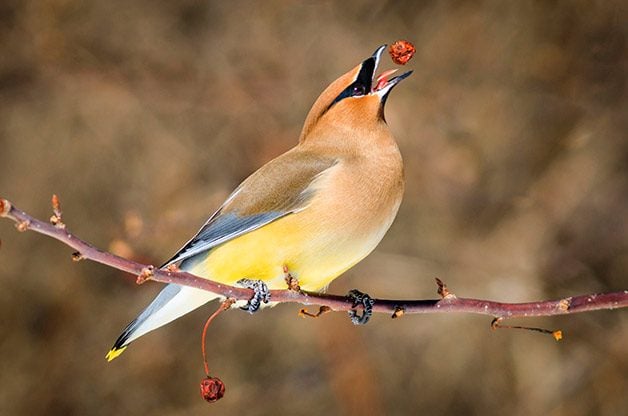
39. Cedar Waxwing
It was incredibly exciting to capture this cedar waxwing tossing a crabapple into the air at just the right moment. The bird’s behavior also was interesting to observe. The waxwing didn’t eat every crabapple—it punctured each one with its pointy tongue to taste the fruit first. Then it discarded some crabapples and ate the others. —Gary Detonnancourt of Harrisville, Rhode Island
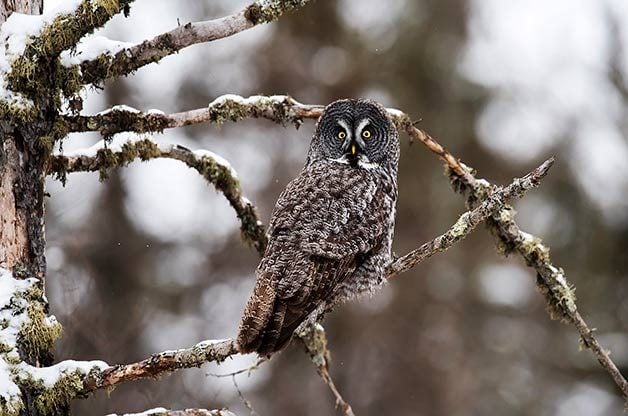
40. Great Gray Owl
On a cold, gloomy winter day, I was driving through a particularly boggy area in Minnesota, hoping I would see something to photograph. Before I knew it, I came across this majestic great gray owl! It stared me down as I snapped this winter bird photo. —Paul Danaher of Chicago Heights, Illinois
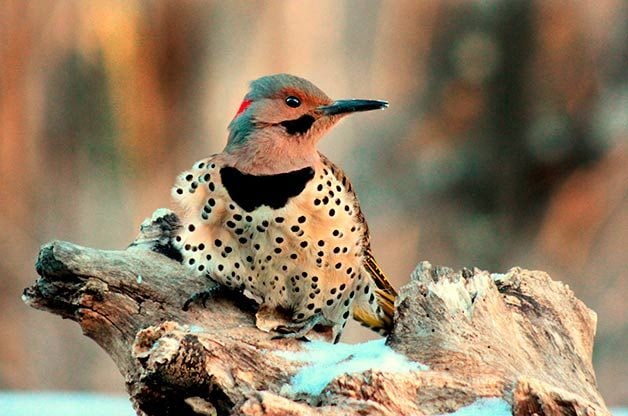
41. Northern Flicker
This male northern flicker visited my suet feeder last year. After he was done feeding, he landed on a stump in my yard and relaxed for a few seconds. I love how his feathers are all fluffed up! I’ve always been fond of this species, from the call they make to the striking feather pattern on their heads. —Janine Martin of North Branch, Michigan
Learn the 4 best foods for attracting woodpeckers.
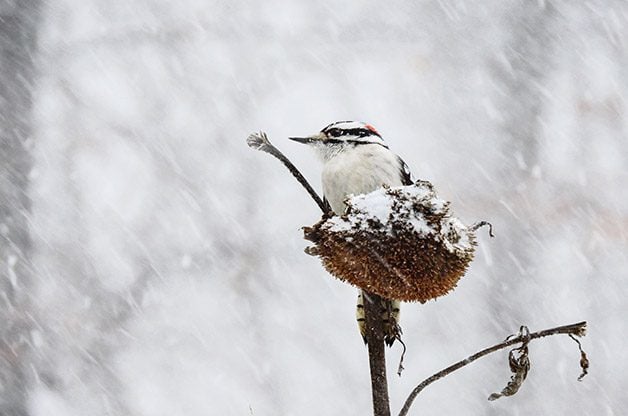
42. Downy Woodpecker
During a snowstorm, a downy woodpecker waited on top of a dried sunflower head for its turn at the feeder. The bird finally got its turn and ate very well. —Nancy Tully of East Stroudsburg, Pennsylvania
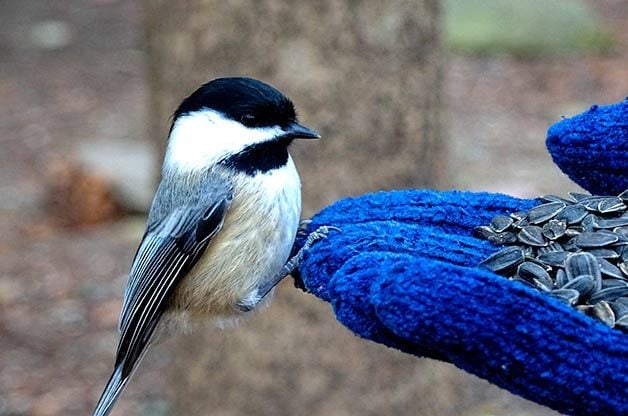
43. Black-Capped Chickadee
On a cold winter’s day, my family and I went to the Brecksville Nature Center in Brecksville, Ohio, for its annual Hand Feed a Chickadee event. As bird lovers, we thought it would be great to have birds land on our hands. We were right! —Matthew Bolyard of Euclid, Ohio
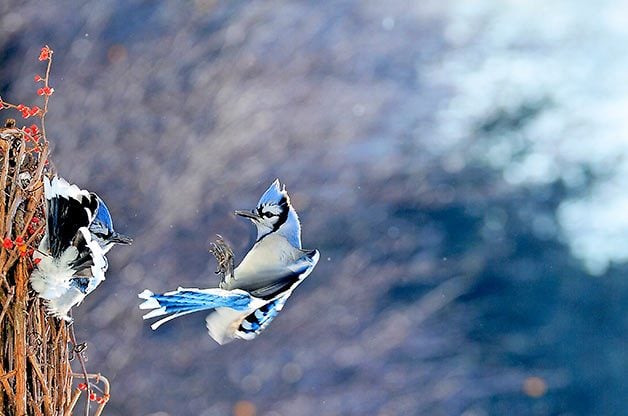
44. Blue Jays
I have a large grapevine wreath mounted over a platform feeder on my deck, and on this particular day, the blue jays seemed to be fighting a little more than usual over the seed. One would be eating and another would fly in and scare it off. The blue jay on the left hopped out of the way a few times, but finally hunkered down, apparently determined not to be bullied off the feeder. —Susan George of Avoca, Michigan
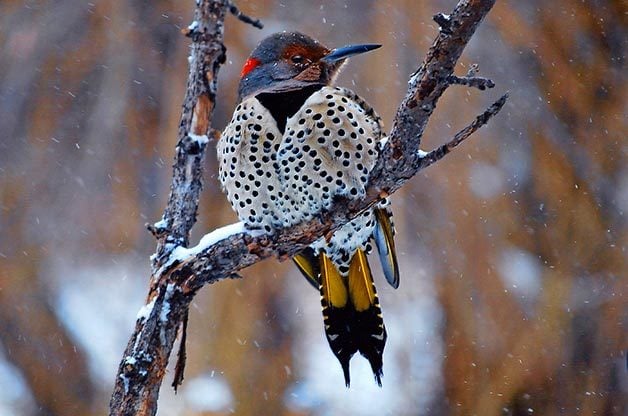
45. Yellow-Shafted Flicker
This gorgeous yellow-shafted flicker arrived on the coldest day of the year. Snow fell lightly as he turned his head from side to side, checking the yard. I was ready with my camera and got several shots as he fluffed up his feathers to keep himself warm. –Jean McCreedy of Edmonton, Alberta
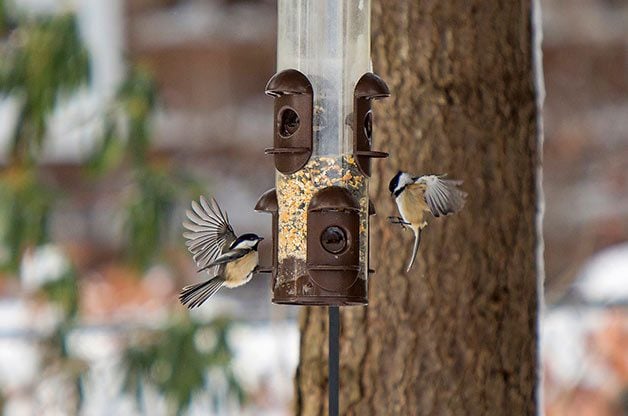
46. Black-Capped Chickadees
A blizzard and frigid temperatures hit our area. The weather and snow were depressing—that is, until the birds came by to enjoy some lunch. I had a delightful time watching and photographing these black-capped chickadees. –Diane Schulman of Dix Hills, New York
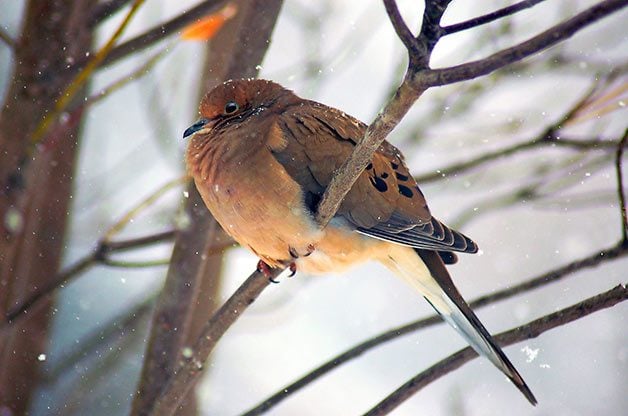
47. Mourning Dove
Whenever it threatens to or begins to snow, I make sure all the bird feeders are stocked, so my backyard becomes a popular hangout for winter birds. This mourning dove found a comfortable sweet bay magnolia tree branch to sit out the snowstorm. —Ray Parisi Jr. of Kennett Square, Pennsylvania
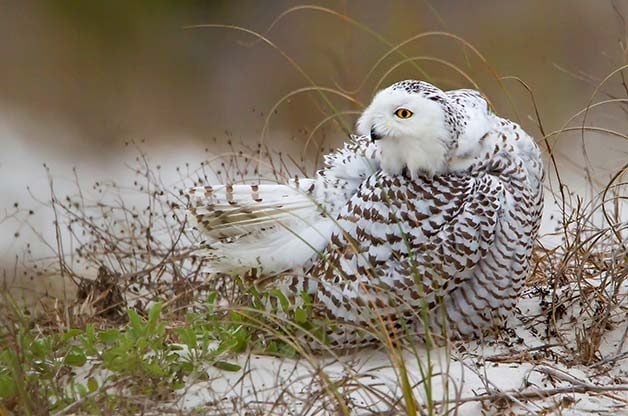
48. Snowy Owl
Two winters ago, a snowy owl showed up in Florida for only the third time in recorded birding history. My wife and I traveled to Little Talbot State Park, near Jacksonville, to photograph this phenomenon. On a chilly, windy morning, with the help of the park rangers, we found the female snowy owl in the sand dunes along the beach. What a thrill it was to see this beautiful bird so far from her Arctic home. —Ed Boos of St. Petersburg, Florida
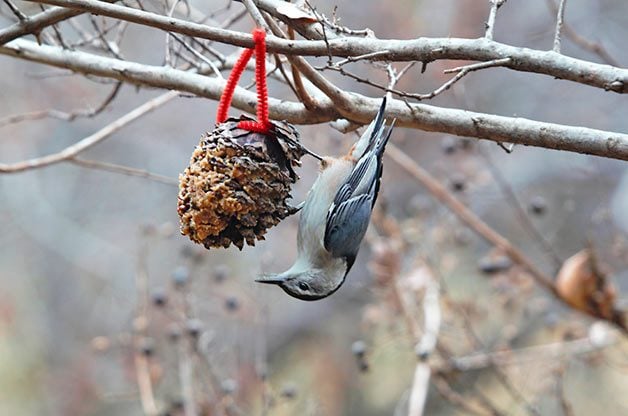
49. White-Breasted Nuthatch
I spied this white-breasted nuthatch just hanging around on our peanut butter pinecone at Christmastime. It was a treat for the nuthatch, and a treat for me, too. —Russ Erhard of Van Buren, Arkansas
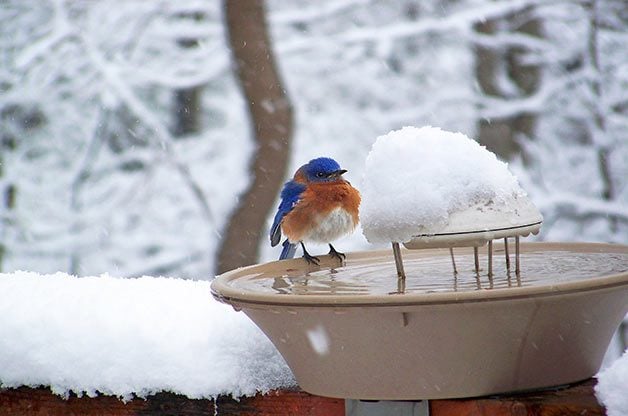
50. Eastern Bluebird
My parents have a lot of bluebirds where they live in Ozark, Missouri, and while I see many beautiful birds here in the St. Louis area, I never see bluebirds. As a nice gesture and a joke, my parents gave me a bluebird house when they visited. Lo and behold, two weeks later, look who comes a-visiting after a snowfall! I heard from a little birdie that my parents sent him. —Christa Garavaglia of St. Louis, Missouri
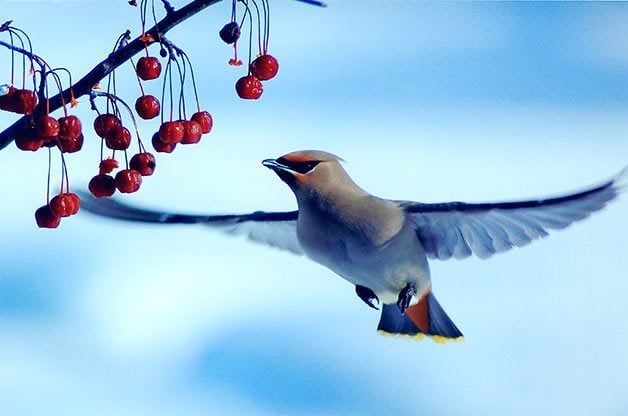
51. Bohemian Waxwing
We used to wonder why we never had to rake up fallen crabapples in the spring. We found our answer one day when I came home for lunch and my wife pointed out the flock of Bohemian waxwings around our crabapple tree. I got some unforgettable photos of the birds taking small fruits off the tree. This was the only time we’ve caught the waxwings during their migration through our area. —Gene Narum of Walhalla, North Dakota
1. Go Birding at Joshua Tree National Park
There are many great things to do in Joshua Tree National Park, but be sure to watch for birds at Cottonwood Spring. It’s one of the few water sources in the park, which sits on the edges of the Mojave and Colorado deserts. Spot southwestern birds like the phainopepla or greater roadrunner, or hike any of the trails that start in the area.
Explore the beauty of another Southwest gem: Verde Valley, Arizona.
2. See the Geology
Visit one of the many geological highlights of this park filled with rugged terrain and ancient rock formations. The most impressive may be Skull Rock, a morbid-looking formation just off Park Boulevard. For more, drive the 18-mile-long Geology Tour Road.
Psst! See our tips for watching birds from your car.
3. Appreciate the Joshua Trees
Mojave Desert natives, Joshua trees thrive in temps from 120 to -13 degrees and can grow up to 30 feet tall and wide (or larger). They are found from Southern California into Utah and are present in most areas of the park. The trees are important for local wildlife—birds such as cactus wrens, American kestrels and northern flickers use the spiky branches as a protected perch, and the yucca moth pollinates the creamy white flowers.
If a trip isn’t in your near future, tour these 35 national parks virtually.
4. Go Rock Climbing
True adventure seekers can scale the rocks in the park. Beginners can hire a climbing guide or take a day class, while more experienced climbers may pick from more than 8,000 routes. Hidden Valley Campground is popular for its proximity to climbing sites.
Check out the best places to camp in national parks.